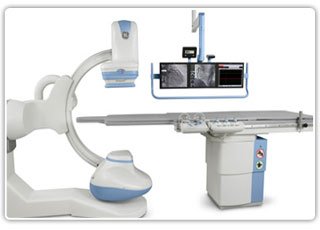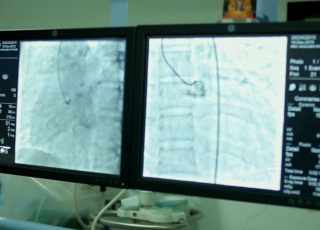India has high mortality of cardiac ailments. Heart attacks are common. Stress tests not necessarily give us information about cardiovascular blockage. To facilitate detection, Horizon has flat panel GE Cath lab. This lab is superior to mobile Cath labs in imaging as well as many other multimodality functions.
We have already performed more than 5000 angiographies for chest pain cases which are suggestive of heart attack. Also, we have successfully performed angioplasties in cases where it was needed.
ST elevation in ECG is such an emergency when urgent angioplasty can save a life. Primary angioplasty is a treatment where intervention is performed very early in the heart attack. This means we intervene before the heart attack is completed.


Angiography
Coronary angiography is a procedure in which a contrast material which can be seen using specialised equipment, is injected into one of the arteries of the heart.
This allows the observation of the blood flow through the heart to detect blockages in arteries. An intravenous line is inserted into one of the blood vessels in the arm or groin area. A catheter is then inserted through the IV which is carefully guided into the heart using an x-ray machine that produces real-time pictures. Once the catheter is in place, a contrast material is injected and images are taken giving the cardiologist a true picture of the region in which arterial blockages lie.The number of blockages and the extent of damage can also be ascertained.
Angioplasty
The arteries of the heart can become narrowed and blocked due to buildup of a material called plaque on their inner walls. This narrowing reduces the flow of blood through the artery and can lead, over time, to coronary artery disease and heart attack, over a period of time.
In angioplasty, a thin tube with a balloon or other device on the end is first threaded through a blood vessel in the arm or groin region up to the site of a narrowing or blockage in a coronary artery.
Once in place, the balloon is then inflated to push the plaque outward against the wall of the artery, widening the artery and restoring the flow of blood through it. A device called a stent is inserted in the area where the artery is narrowed to keep it open. Some stents are “coated” with medication to help prevent the artery from closing again. Stents are used in most angioplasties except when an artery is too small for a stent to fit. This minimizes the damage to the heart.
Congestive heart failure is a condition where early angiography can make a difference in the adequate pumping of the heart.
- 24 hrs. of interventional cardiology support.
- Personal attention by American Board Certified Pulmonary & Critical Care for more than 10 years.
- Visiting physicians of international repute.
Cardiothoracic Surgery
Off Pump CABG
During this procedure, the heart is not stopped (no cardioplegia) and heart lung machine is not used. The heart and lungs continue their normal function while CABG is being performed. This is also called Beating Heart CABG. With the heart still beating, CABG requires greater surgical skills and is available at select centers. There are many advantages of off pump CABG namely lower risk of strokes, faster recovery from surgery resulting in shorter ICU and hospital stay. In high risk patients with impaired kidney function, poor heart function or Redo CABG (second time) this surgical technique is better as it provides protection to the heart.
All arterial Grafts
What is very crucial for the long term success of CABG is what is being used as a graft to bypass the blocked coronary artery. Most surgeons use veins from legs for this purpose and this leads to blocked grafts within a few years. But the use of arteries from the chest and hand for bypassing the blocked coronary arteries can help avoid this. This is called All Arterial CABG.
It has been conclusively proven by studies that chest arteries (IMA) have better patency than veins and even drug coated stents. The only problem of All Arterial CABG is that it is technically more demanding and the surgeon needs to be specially trained.
CABG without blood Transfusion
The cell saver machine collects the blood lost during surgery cleans it so that it can be given back to the patient. This eliminates all the risks involved with blood transfusion –HIV, Malaria, Hepatitis etc. In patients with normal haemoglobin, CABG can be performed without blood transfusion using this machine.
CABG with No Touch Aorta technique
The possibility of avoiding the manipulation of the aorta plays a key role in protection of brain in off-pump CABG. Dr Saha has devised a new surgical technique to avoid direct aorta manipulation. This eliminates the risk of stroke after CABG.
MICAS – Minimally Invasive Cardiac Surgery Minimally invasive heart surgery (also called Keyhole Surgery) is performed through small incisions, sometimes using specialized surgical instruments. The incision used for minimally invasive heart surgery is much smaller about 3 to 4 inches. Minimally Invasive Cardiac Surgery (MICAS) or Minimally invasive direct coronary artery bypass graft (MIDCABG)


